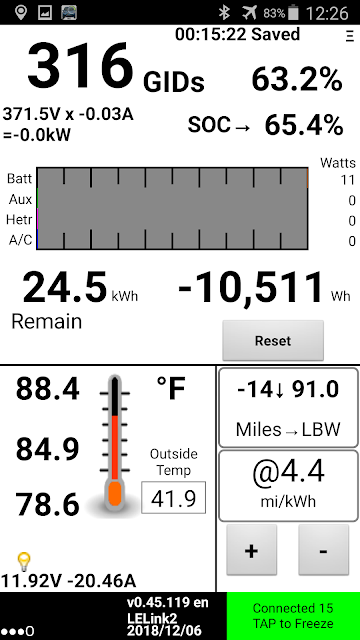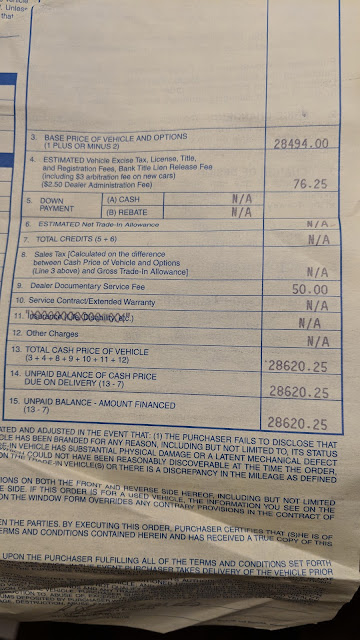I am not a paid by LEAF Spy developer Jim in any way or form. The opinions below are strictly mine and unbiased in any way.
We are now entering the 4th day of Winter which means two things;
Merry Christmas!!
and
We are quickly approaching post 1000 of "my range is dropping and I don't know why."
Forget that its cold and rainy and snowy. Nearly all these statements are based on the GOM which pretty much explains everything. Do not use the GOM to evaluate your LEAF's performance. It was never good for earlier model LEAFs but the 40 kwh LEAFs takes it a step farther by adding a significant amount of hidden range.
LEAF Spy Range Setting
LEAF Spy allows you to set your range based on "you" and "your" driving situation. Now, there isn't any presets so you have to know a bit about your car. This should be the easy part, right? You drive it every day and if you are resetting the trip meter every day, you have a pretty good idea of your miles/kwh performance. There are a few settings you need to determine;
Efficiency
Now as we know, that number changes due to weather, rain, climate control usage, etc. So a bit of data collection will go a long way towards getting you an accurate picture of just how far you can go but in reality, if you don't want to collect the data, that works too. Simply pick a number and try it. At the end of the day, review the number against the car's and see if you need to adjust up or down while noting any specific situations that may have affected the numbers.
For me; I use a general average that low balls it a bit during Summer of 4.5 miles per kwh but use 3 different ones for Winter due to the much greater variance in weather and road conditions.
DoD (Depth of Discharge)
This setting allows you to see what your range estimate is to a specific SOC. There are presets for LBW and VLBW and a custom one you can choose from 1% to 25% in 1% increments. Choose whatever you are comfortable with. For me? I want to know what my range is, period. But 1% SOC is as low as it will go so that is what I chose. Below we are looking at the two lower right boxes.
The one on top says I have 100.5 miles estimated to 1% SOC. Tapping this box will toggle from my setting to LBW or VLBW. The box below is using 3.6 miles/kwh to calculate my estimated range.
Now if 1% is just one of those "standing on a cliff peering over the side" kinda things for you, you can increase it up to 25% in the settings under the Range subcategory.
Drawbacks
Well nothing is perfect so knowing the limitations of the system you are using is simply a good thing, right? First off, LEAF Spy range settings are a bit of trial and error. There will always be a "first" time coming where your range will be well short of your LEAF Spy prediction. After all, we are taking a full day's average and applying it minute by minute to our drive that includes uphills, downhills, tailwinds, headwinds and even unexpected squalls! So how can one static number work for all that?
Well, obviously it doesn't so again, having an idea of your driving performance is the key. Resetting the miles/kwh meter daily helps, is super easy to do and takes like 2 seconds. Recording a daily log of driving for several months to cover the entire year of seasons you will see is not. So like any good thing, there is no free lunch.
But as an EVer, I am guessing you already know that. The sheer volume of accessories you can buy to charge your car should be more than enough of a hint that being truly successful means thinking outside the box.
GOM Drift
This will make like what? entry #4 or 5 where I mentioned the inconsistency of the GOM range prediction. The GOM is supposed to estimate your range remaining based on recent driving performance and the estimated charge available in the battery pack, right?
Uhhh, no. Not even close. In fact, I really have no clue how the GOM does its calculations and here is why I am confused.
The Test
Well driving around and recording GOM verses LEAF Spy numbers simply doesn't work due to the unquantifiable variability of real life conditions so, I figured the best way to overcome that variability is to use a static set of numbers for the GOM calculation just as LEAF Spy does all the time. To put it another way, I simply parked it. This ensures that the "recent" driving history supposedly used by the GOM to calculate the range would not change.
GOM Bloat
So off to the charger I went putting 30 miles on the car to get a good reset of the miles/kwh meter. Now we always complain our GOM drops fast in the morning completely deflating our elation at the lofty range we see first thing? Well there is a reason for that.
From the dash we see the LEAF at 84% with a 137 mile estimate from a 4.2 mile/kwh performance. But LEAF Spy is telling us we will only get 123.7 miles at 4.0 miles per kwh. So GOM is overestimating a range by 14.3 miles.
But wait!! you say. The car is doing better than LEAF Spy at 4.2 miles per kwh over the LEAF Spy's 4.0 miles per kwh so it should predict a higher range, right?? I will comment on this later but keep this in mind.
Like a Stopped Clock, the GOM is right...Once a charge
LOL!! Sorry couldn't resist that heading... Now, here we are earlier in the same charge so the GOM is still using the very same "recent driving history" and guess what?? LEAF Spy agrees!! So the GOM is not "always" wrong, right? Notice the SOC being so near the middle? Interesting, right!
Your LEAF's range is MUCH better than the GOM lets on
Truth be told; Who cares about how much range you have left when you have 100 miles? NO ONE!! What we care about is our range when the car has nothing to say but "_ _ _"
That is where LEAF Spy shines and quickly becomes an inconsequential expense when we realize just how much of a stress reliever it is!
Ok, now we have the GOM still using the same recent driving history saying we only have 32 miles of range (Which BTW, will disappear in about 22 miles...) while LEAF Spy says we have 43.1 miles of range.
Now for some reason, I don't have the shot I took before starting the charge which had my GOM at "_ _ _" and LEAF Spy at 17 miles but when I find it I will update it.
Drawbacks
Do I really need to list them out? Lets face it, even to most inexperienced EVer immediately recognized that the GOM was kinda...well full of it. Now it should be a bit obvious that the GOM isn't as bad as we think with its bloated morning readings. What is happening is a slow shift to the hidden reserve (This can be verified by the changing gap between LEAF Spy's real SOC verses the usable SOC on the dash) resulting in a GOM error that ends up being relatively small or you could simply use the LEAF Spy reading which I find tends to be within 2-3%. Of course this means you having had picked the correct number.
Finally, lets talk about that recent history a bit. No one knows exactly how much "history" is used in producing the GOM figures (assuming the number is not pulled out from a magician's hat) but since I was there, I can shed a bit more light on that.
First off, the 30 miles was done in two stints. The morning drive to work which was 12.1 miles and 3.6 miles per kwh. So the afternoon part of the drive was MUCH more efficient than the 4.2 miles per kwh suggests which simply makes the error of the GOM larger than I have shown here.
IMHO, the GOM is Nissan's way of "babying" us. Telling us what we want to hear. Notice the SOC differences? In the first pix, the dash SOC is 84% which represents usable SOC while LEAF Spy SOC is 83.2% which is real SOC. In whose World does usable outdo real??
But as the SOC drops, Nissan moves towards making sure we don't put ourselves in a "tow of shame" situation which you can see in the last pix where usable is 19% while real is 29.2% It's that lower gap that is really the whole point of this post. What is really usable is completely dependent on your pack's balance since a single cell can shut the car down. So there is no "magic GID" number that you can aim for. I can say for certain, I have hit turtle at 9 GIDs and not seen Turtle at 5 GIDs. So the bottom very much remains a mystery but at that point, we are talking less than a mile.
Conclusions
Said it once and will gladly say it again; LEAF Spy is by far the best investment I have made in helping to get the most out of my LEAFs.
The other conclusion; GOM is a very accurate name. :)































